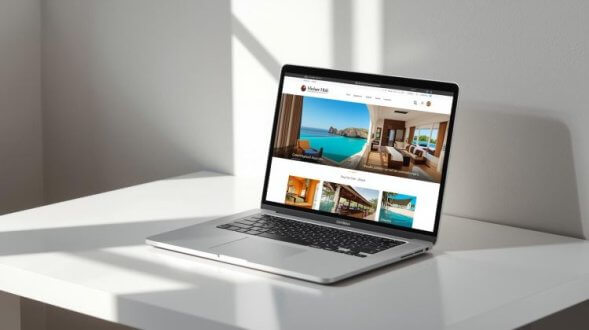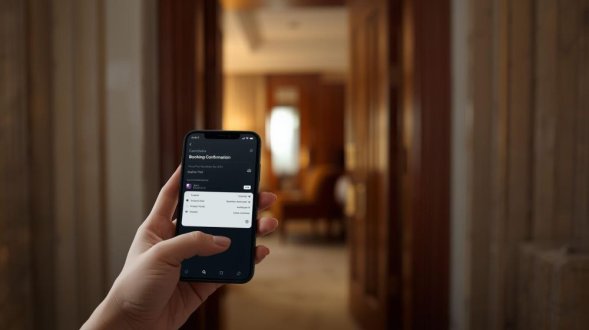Imagine a scenario where a family is planning their much-anticipated family trip. After weeks of searching, they’ve landed on your website full of excitement. Their credit card is practically vibrating on the desk. The family can almost taste the welcome drink and feel the plush robes.
But then, it happens.
The stunning hero image takes forever to load; the guests can’t immediately tell if you have a spa. The “Rooms” page is a confusing grid of thumbnails that all look the same. When they finally find a room they like, the calendar widget is clunky, and a nagging doubt creeps in: “Is this place as professional as it looks?”
Three clicks later, they’ve hit the back button. A quick Google search leads them to your competitor, whose website feels effortless; they book there instead.
You’ve just lost a booking, not because your beds aren’t comfortable or your staff isn’t wonderful, but because your digital concierge – your website failed at its first and most critical task. This silent, daily attrition of potential guests is the leak in your revenue stream that you might not even see.
If you’re pouring your heart into the physical guest experience but treating your website as a digital brochure, you’re working against yourself. To correct that, let’s walk through the four key stages of the user journey and transform your website from a passive informant into your most effective booking engine.
1. First Impressions in the Digital Lobby

Your homepage is your property’s curb appeal. In the three seconds it takes a visitor to decide if they’re in the right place, your site must perform flawlessly.
The 3-Second Rule: Your value proposition must be instant and visceral. Are you a beachfront paradise? Hit them with the sound of waves and a sunset over the water. A chic urban retreat? Showcase the skyline from your rooftop bar.
Visual Appeal: Showcase a unique setup of your property to increase online bookings. Travelers crave authenticity. Invest in high-quality, professional photography and video that showcase your unique property.
Clarity Over Cleverness: Your navigation is not the place to be poetic. Labels like “Accommodations” are fine, but “Nest” or “Abode” can confuse. Stick to the classics – Home, Rooms, Amenities, Gallery, Contact, Blog. Your goal is to be intuitive, not cryptic. Think of your main menu as your concierge desk, clearly signposted and easy to find.
Website Accessibility: More often, travel planning, research, and bookings happen on smartphones. If your site is slow to load, images are distorted, or the “Book Now” button is tiny and hard to tap on a mobile screen, you have already lost. Your mobile site isn’t a scaled-down version; for many, it’s the primary version.
2. Guiding Guests from Curiosity to Conviction
They’re interested. Now, you need to convince them. This is where you move from showcasing your lobby to giving them a personalized tour.
A room page should be a destination, not a footnote. Create an immersive gallery with high-resolution photos of the bed, the bathroom, the view, and any unique features.
Don’t just list your amenities; bring them to life. Instead of “Swimming Pool”, show a short video of the pool at golden hour. Don’t say “Award-Winning Restaurant”, showcase your menu, feature a chef profile, or include photos of your signature dishes.
You’re not selling a room; you’re selling an experience. The room is just where they’ll sleep between the experiences you provide.
A photo of a smiling guest from your Instagram feed is good, but a verified review that says “The staff went above and beyond for our family trip” is pure gold.
Position yourself as the insider’s guide. A curated blog post like “Our Guide to the Hidden Gem Restaurants You Won’t Find on TripAdvisor” or “The Best Sunset Hiking Trails 10 Minutes from Our Door” does two things – it provides immense value, and it sells a lifestyle.
3. The Seamless Check-In

They’re convinced. Now, for the love of all that is holy, don’t trip at the finish line. The booking process is where many hospitality websites reveal their cracks.
The Booking Engine
The most critical piece of technology on your site. Online bookings must be fast, fully integrated with your PMS, and visually cohesive with the rest of your brand. Website should handle special requests (e.g., “late checkout”, “allergies”), manage multiple rate plans, and elegantly present upsells like airport transfers, spa treatments, or that bottle of champagne for the room. A third-party booking engine that feels disconnected from your beautiful site erodes trust instantly.
The Anxiety of Hidden Costs
Be very transparent about pricing. The best practice is to show a total price, including all taxes and mandatory fees, as early in the process as possible. A surprise “resort fee” or “cleaning fee” at the final step is the digital equivalent of a bait-and-switch and is a primary driver of cart abandonment.
Reducing Abandonment
An exit-intent pop-up that triggers when a user is about to leave can recapture a surprising number of bookings. The offer should be gentle and valuable: “Book today and receive a complimentary welcome drink for two”, or “Need help deciding? Let us answer your questions.” It’s your digital staff member gently asking, “Is everything alright? Can I help you with anything?”.
The Post-Booking Nurture
The journey doesn’t end with a confirmation number. An automated, beautifully designed confirmation email should do more than just list a reservation ID. It should start building excitement – “We can’t wait to welcome you!” and provide useful pre-arrival information: weather forecasts, transportation tips, and links to your restaurant cuisine. You’ve just shifted from sales to service, and it feels great.
4. Beyond the Stay, Turn Your Guests into Advocates
A guest’s departure is your next opportunity. A memorable stay can lead to a lifetime of loyalty.
Feedback: A few days after checkout, send a personalized email thanking them for their stay. Ask them about the experience during the stay, and their positive feedback will encourage others to book with you.
Social Media Integration: Make it easy for guests to share their experiences on social media. Use a unique, property-specific hashtag and display your social feeds on your website. Encourage users to tag you in their photos. User-generated content is the most trusted advertising you will ever get.
Building an Email List: Not every visitor is ready to book. Capture their interest with a “Sign up for exclusive offers and local insights” call-to-action. Build a database of warm leads you can nurture with beautiful newsletters and special promotions – turning “maybe someday” guests into “book now” guests.
Optimizing every step of this digital guest journey isn’t just about tweaking a website; it’s about architecting a strategic, revenue-driving asset. It requires a deep understanding of both hospitality psychology and conversion-focused website design.
At NCrypted, our hospitality website design services are built specifically for this purpose. We don’t just build websites; we craft seamless, bookable experiences that mirror the quality of your service, turning casual browsers into loyal guests and safeguarding your digital front door.



